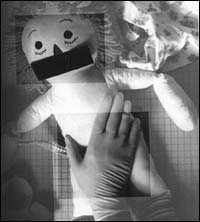 Sexual violence isnít a new phrase, but it is a phrase being heard more and more in the state and national media. It is used when talking about sexual abuse and assault.
Sexual violence isnít a new phrase, but it is a phrase being heard more and more in the state and national media. It is used when talking about sexual abuse and assault.Sexual violence isnít something that is talked about in every community. It is there, however, according to law enforcement authorities.
Sexual violence affects people far beyond the victim. The impact of sexual violence in communities alters relation-ships within families, at schools, and in the work place.
So just what do we mean by the term, sexual violence? According to the Minnesota Commissioner of Health, Anne Barry, sexual violence is words and actions that violate a person sexually. This violence breaches the dignity of a person.
Children are often sexually violated by parents, family members or other people they know and trust. Kids may be coerced to perform or observe sexual acts, or are introduced to explicit sexual material. Children and young adults are also vulnerable to abuse by other young people. Unwanted touching of body parts, name-calling, and being pressured for sex is a problem for kids in their everyday lives. While dating, teens may be forced into sexual acts against their will. Sexual violence recognizes no income, age, gender, sexual preference, or cultural boundaries.
Jackie Campbell, Paynesville Area High School counselor, said students face many problems such as peer pressure, physical abuse, and harassment. ďI feel more families with abuse issues are coming forward and getting attention, but in the Paynesville area, it is more physical violence and neglect than sexual violence.Ē
ďIím not saying sexual violence is not out there, it happens in almost every community. However, family members are afraid to come forward and report the abuse in smaller communities,Ē Campbell added.
Tony Schmitt, Paynesville Police Chief, said the department has not received any sexual violence calls this year. However, since the first of the year, the Paynesville Police Department has responded to three child abuse cases and ten domestic incidents within their jurisdiction of the city of Paynesville and Paynesville Township.
Kathy Oxenreider from Woodland Center, a counseling center in Willmar, said there are quite a few sexual violence reports in the Willmar area.
ďPeople in larger communities are more willing to report the crime,Ē Oxenreider said. ďMany victims have such rage, they want other people to know. Often times, the publicity brings forth other victims of the perpetrator.Ē
Dr. Kathy Sweetman at the Lakeview Clinic in Waconia, reports that well over 50 percent of women who come to emergency departments with various complaints such as headaches, minor injuries, and abdominal pain are really there for abuse-related issues. ďWe see a lot of people in denial,Ē she added.
Children inundated with violence
Dr. Sweetman added the media can be used in positive ways, but the fact is that we know our children are being inundated with violence in the media. Theyíre seeing sexual violence on television and in the movies. They are receiving negative messages about gender roles and stereotypes that are damaging, and which promote violence, but particularly sexual violence. This is a real significant problem in our culture. Kids seem to learn from what they see and hear.
ďWe as adults are afraid to talk to our children about sexual violence, as it is something that is outside of our comfort zone. The media is and has been talking positively to children about sexual violence. Shows are planned and produced around specific messages. Kids are getting messages, and theyíre not necessarily getting the messages we want them to hear,Ē Dr. Sweetman said at a recent town meeting on sexual violence held in Appleton.
At the town meeting on sexual violence, Bonnie Clairmont, an advocate for victimís rights, stressed many victims remain silent because itís not safe to talk about their abuse, because of the attitudes that prevail about why sexual violence happens. Most of the time those are real victim-blaming kind of attitudes.
Chris Carpen, a survivor of sexual violence speaking at the town meeting, said it is a crime people talk about the least. ďIn small towns, the crime hurts us more, because we know the people, especially in cases with children,Ē she said.
Consider these sexual violence facts:
ēIn a national survey of women, 13 percent reported having been forcibly raped at least once in their lives.
ēIn a recent survey of women in rural Minnesota, 20 percent reported having experienced sexual abuse before the age of 18.
ēAmong Minnesota ninth graders in public schools, 14 percent of girls and four percent of boys report having been a victim of sexual abuse.
ēAmong ninth graders who have used alcohol, marijuana, stimulants and other drugs, girls are five times more likely and boys 12 times more likely to have been sexually abused.
ēVictims of sexual violence may experience a wide range of serious health problems, including post-traumatic stress disorder, depression, sexually transmitted disease, unwanted pregnancy, chronic pain, and injury.
ēOne fifth of Minnesotaís prison inmates are in prison because they have been convicted of criminal sexual conduct.
ēThirty-three percent of teenage prostitutes were sexually abused by a family member and 65 percent were sexually assaulted by nonfamily members.
ēAt least seven Minnesotans are raped every minute.
ēThree out of four perpetrators know their victims.
ēOnly 29 percent of parents discuss sexual abuse with their children.
The Minnesota Department of Health is supporting local communities and is working together with the Minnesota Center for Crime Victim Services, the Minnesota Coalition Against Sexual Assault and other organizations to develop innovative strategies to prevent sexual violence.
People needing help with sexual violence are urged to call First Call for Help, a 24-hour crisis information center, at 1-800-543-7709.